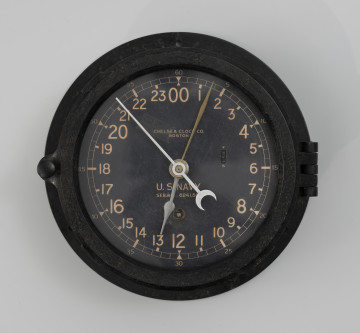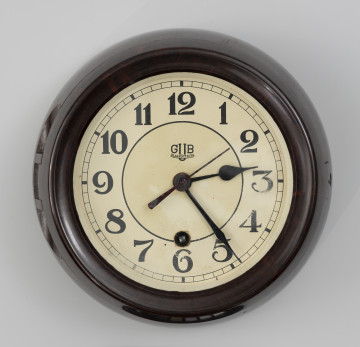
Ship clock
1941 — 1945
National Museum in Szczecin
Part of the collection: Navigation history
A significant problem for sailors in the 18th century was determining the longitude of a ship at a particular time. While latitude was relatively simple to calculate based on the position of the North Star or the Sun above the horizon, the latitude at which a ship was located was calculated by means of dead reckoning, which was based on determining the distance travelled by a vessel from its last observed position, using a covered course and speed. However, positions defined in this manner did not take into account wind directions and sea currents. One solution would have been to calculate longitude based on the difference in time between noon at Greenwich, through which the 0° meridian runs and the locally determined solar noon. However, for this method to yield tangible results, a very accurate timepiece was needed. The first clock with a measurement error of fewer than 2 minutes, equivalent to half a degree of longitude in navigation, was built in 1759 by John Harrison (1693-1776). With a fluctuation of one second per month, this chronometer enabled a very accurate calculation of longitude at sea. The featured clock was manufactured by the German state-owned VEB Glashütter Uhrenbetriebe (GUB), founded in 1845 and still operating today under the name Glashütter Uhrenbetrieb. The piece pre-dates the quartz era, in which the seconds hand advances in half-second increments and the spring pull theoretically permits a 56-hour movement. In practice, however, the chronometer was wound every 24 hours. It required 8 and a half counterclockwise turns at the same time every day. To control the possible measurement error of the device, the reading was compared with the radio signal from Greenwich every day, and the data was recorded in the chronometer logbook. Leszek Kocela
Author / creator
Object type
chronometer
Technique
batch production
Material
brass, wood, colourless glass, plastic
Origin / acquisition method
purchase
Creation time / dating
Creation / finding place
Owner
Muzeum Narodowe w Szczecinie
Identification number
Location / status

1941 — 1945
National Museum in Szczecin

1955 — 1970
National Museum in Szczecin

circa 1962 — 1980
National Museum in Szczecin
DISCOVER this TOPIC
Castle Museum in Łańcut
DISCOVER this PATH
Educational path